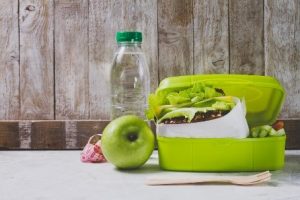20 Guidelines for healthy lunches in Japanese
Natalie Loosemore
Guildelines for healthy lunches in Japanese
健康的な給食に何を入れる
学年を始めるために健康的な弁当を計画してみてください。子供たちに話し,子供たちが何を含めさせてもらうことを話し合います。
健康的な弁当箱の6つの重要な部分は次のとおりです。
新鮮なフルーツ
新鮮なカリカリ野菜
牛乳、ヨーグルト、チーズ(2歳以上の子供には減脂肪オプションを使用できます)。乳製品を許容できないお子様には、カルシウム強化大豆や米飲料、大豆ヨーグルトなどの適切な代替品を提供
いくつかの赤身の肉(例えば、鶏肉のストリップ)、ハードボイルド卵やピーナッツバターのような肉や肉の代替食品。学校にナッツフリーのポリシーがある場合、ピーナッツバターやその他のナッツはお子様のお弁当に含めないでください。
パン、ロールパン、フルーツパンまたはクラッカーのような穀物または穀物食品(全粒粉または全粒粉の選択が最善である)
水道水。

給食と食の安全
食べ物は通常、数時間弁当に保存され、食べ物が新鮮なままになるように弁当箱を冷たく保つことが重要です。お弁当箱を安全に保つためのヒントを次に示します。
絶縁弁当箱または冷凍庫パック付きのランチボックスを選択してください。
冷たくしておくべき食品(チーズ、ヨーグルト、肉、サラダなど)の横に冷凍水筒または冷凍レンガを詰めます。
乳製品、卵、スライス肉などの生鮮食品は冷たく保ち、準備から約4時間以内に食べるべきです。調理するだけなら、これらの食べ物を詰めてはいけません。まず冷蔵庫で一晩冷やします。
お弁当を前もって作る場合は、学校に行くまで冷蔵庫に入れておくか、事前に冷凍しておいてください。肉、パスタ、米料理などの残りの食事を含める場合は、お弁当に冷凍アイスブロックを詰め込んでおきます。
子供たちに、ランチパックをランドナゴに入れておき、バッグを直射日光の当たないようにし、ロッカーなどの涼しく暗い場所に入れてください。
Translation: What to put in healthier school lunches
Try planning a healthy lunch box to start the school year. Talk to your children and discuss what they would be happy to have included.
The six key parts to a healthy lunchbox include:
• fresh fruit
• fresh crunchy vegetables
• milk, yoghurt or cheese (you can use reduced-fat options for children over the age of two years). For children who cannot tolerate milk products, offer appropriate alternatives like calcium fortified soy or rice drink or soy yoghurt
• a meat or meat alternative food like some lean meat (e.g. chicken strips), hard-boiled egg or peanut butter. If your school has a nut-free policy, peanut butter and other nuts should not be included in your child’s lunchbox
• a grain or cereal food like bread, a roll, flat bread, fruit bread or crackers (wholegrain or wholemeal choices are best)
• tap water.
• Cut up large pieces of fruit and put them in a container – this makes it easier to eat, especially if your child has wobbly teeth or if they have less time to eat than they are used to. Send a damp face washer to help with extra juicy fruit.
• Consider giving half a sandwich or roll for morning recess, as this is an easy way to get a healthy fill.
• In the hot weather, send frozen milk, yoghurt or water, or even frozen orange segments. This makes a great refreshing snack and helps to keep the lunch box cool.
• Go for colour and crunch in the lunch box by offering a variety of colourful vegetables and fruit.
There are many websites where you can find ideas for a healthy and interesting school lunch (e.g. https://www.betterhealth.vic.gov.au/health/healthyliving/healthy-eating-school-lunches.)
School lunches and food safety
Food is usually stored in lunchboxes for several hours and it is important to keep the lunchbox cool so that the food stays fresh. Some tips to help keep lunchboxes safe include:
• Choose an insulated lunch box or one with a freezer pack.
• Pack a wrapped frozen water bottle or freezer brick next to foods that should be kept cold (for example cheeses, yoghurts, meats and salads).
• Perishable foods such as dairy products, eggs and sliced meats should be kept cool, and eaten within about four hours of preparation. Don’t pack these foods if just cooked. First cool in the refrigerator overnight.
• If making lunches ahead of time, keep them in the fridge until leaving for school or freeze them in advance.
• If you include leftover meals such as meats, pasta and rice dishes, make sure you pack a frozen ice block in the lunch box.
• Ask children to keep packed lunches in their school bag and to keep their bag out of direct sunlight and away from heat, ideally in a cool, dark place such as a locker.
Rationale
This resource is a translation of part of the department’s guidelines for school lunches (“Healthy eating – school lunches”, 2015). The parts that have been translated in Japanese are what to put in healthier school lunches and school lunches and food safety. To translate this resource the site translator EU was used (“English – Japanese translation”, 2019). The translator can be used to translate the document into other language to accommodate all nationalities within your school. This will give families a feeling of belonging as you provide literature in their home language. “A sense of belonging and welcome is essential if families are to feel comfortable being in your service,” (Department of Education & Training, 2012). This resource is to be used to help parents with culturally diverse backgrounds prepare school lunches. It should be given out to parents whose children will be starting school the following year so that the children can enjoy foods, at school, they would usually eat at home. “Educators recognise that diversity contributes to the richness of our society” (Department of Education, Employment & Workplace Relations, 2009, p. 13). To be culturally competent an early childhood service needs to provide effective and appropriate service delivery to individuals and families from non-dominant cultural groups. This can be done by having resources in the families home language which will support their understanding.

